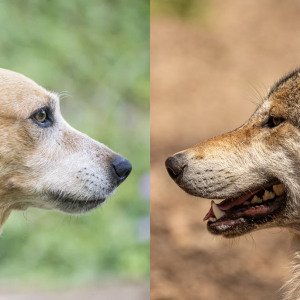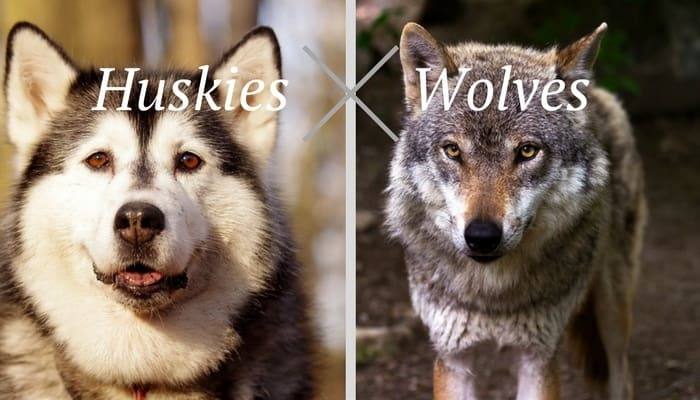Wolves Vs Dogs / Siberian Husky Vs Wolf Are They Related Differences Similarities / 3) dogs have smaller brains compared to wolves.
Wolves Vs Dogs / Siberian Husky Vs Wolf Are They Related Differences Similarities / 3) dogs have smaller brains compared to wolves.. But a large wolf can bite down with over 1,200 pounds of pressure, this is deadly to any dog breed. When observing an animal, it is desirable to consider as many of the following traits as possible, including the animal's behavior. Dogs bond easily with humans while wolves bond best with other wolves. It is estimated that wolves have a brain that is around 30 percent larger than the brain of a domesticated dog. The long time that separates dogs and wolves has made the majority of canine breeds present a different appearance than the wolf:
The alaskan malamute, siberian husky and other dogs that look like wolves are more closely related to the wolf, than say, a poodle is. They live in tight family groups and are uninterested in human connections. Today's domestic dog is approximately as genetically similar to the wolf as we humans are to chimpanzees. Actually, pretty much none in rl. Usually wolf footprints are bigger than those of dogs.

Both dogs and wolves are very closely related animals as their features and characteristics are almost alike.
Dog pups develop more slowly than wolf pups. The wolf and the dog hang together taxonomically all the way down through genus and only separate when classified as separate species; While agile, wolves are built more for endurance than speed. Both dogs and wolves can be territorial, but wolves are likely to kill interlopers as competition or food. About press copyright contact us creators advertise developers terms privacy policy & safety how youtube works test new features press copyright contact us creators. In general, the domestic dog is an extremely close. So is lycaon a dog or a wolf? Although considered big dogs, only the largest equal the size and weight of the smallest wolf. But a large wolf can bite down with over 1,200 pounds of pressure, this is deadly to any dog breed. Wolf puppies might have blue eyes at the start, before they age in a few months to their final color (perhaps amber, or yellow, or green.) and sometimes a wolf's pale green eyes might be confused for blue. Only domestic dogs have blue eyes. Dogs bond easily with humans while wolves bond best with other wolves. But different breeds of dogs are more closely genetically related to each other, and not their wolf counterpart.
Wolves seldom bark, except in alarm; When observing an animal, it is desirable to consider as many of the following traits as possible, including the animal's behavior. 2) dogs have a head that is smaller than wolves. According to the integrated taxonomic integration system, wolves come in three species, but on average they range in height from 2.2 feet to 2.7 feet. Both dogs and wolves can be territorial, but wolves are likely to kill interlopers as competition or food.

Researchers analyzed the genomes of wolves from three likely sites of domestication (the middle east, asia and eastern europe), and found that modern dogs were not more closely related to any of the three.
Dogs and wolves split from a common ancestor around 34,000 years ago. Researchers analyzed the genomes of wolves from three likely sites of domestication (the middle east, asia and eastern europe), and found that modern dogs were not more closely related to any of the three. There is still a bit of disagreement about this among scientists. However, the differences still exist between them mainly with regard to their habits and some of the other aspects as well. According to the integrated taxonomic integration system, wolves come in three species, but on average they range in height from 2.2 feet to 2.7 feet. When observing an animal, it is desirable to consider as many of the following traits as possible, including the animal's behavior. About press copyright contact us creators advertise developers terms privacy policy & safety how youtube works test new features press copyright contact us creators. This is because all of our domestic dogs are descendants of the eurasian wolf (canis lupus), including our great dane and beloved chihuahua.from a scientific standpoint, they are all in the same family known as canidae. The paw of a dog is half the size of that of a wolf, and some dog's tails curl upwards, unlike that of a wolf. Actually, pretty much none in rl. Unlike dogs, wolves are not as socially accepting of strangers. Dogs mark territory and sound alarm barks more frequently than wolves. Wolves' heads are much larger in comparison to their body size than dogs' heads are.
As humans and dogs settled in one place, these behaviors made canines useful guard animals. However, the differences still exist between them mainly with regard to their habits and some of the other aspects as well. Because of their close genetic similarity, dogs and wolves share many physical traits. Generally, a dog's head is 20 percent smaller than the head of a wolf. Wolves seldom bark, except in alarm;

Wolves are high activity, whereas dogs can be active or sedate.
They live in tight family groups and are uninterested in human connections. According to the integrated taxonomic integration system, wolves come in three species, but on average they range in height from 2.2 feet to 2.7 feet. Wolves and dogs are separated by 15,000 years of evolution, during which time the species have veered off into radically different directions. Appearance the obvious place to start is with appearance. Wolfs never fight without purpose, so if a wolf attacks a dog, it means he is hunting and will eat the dog. Unlike dogs, wolves are not as socially accepting of strangers. Dogs bond easily with humans while wolves bond best with other wolves. Dogs mark territory and sound alarm barks more frequently than wolves. Dogs accept strangers more readily than wolves. About press copyright contact us creators advertise developers terms privacy policy & safety how youtube works test new features press copyright contact us creators. Wolves' heads are much larger in comparison to their body size than dogs' heads are. In fact, it seems that the closest wolf ancestors of today's dogs may have gone extinct, leaving no wild descendants. The size of a wolf may vary very little from one individual to another, but one canine breed with respect to another can make a big difference in this respect.;
Komentar
Posting Komentar